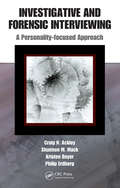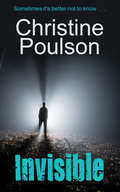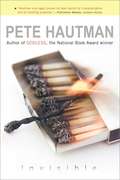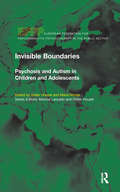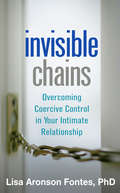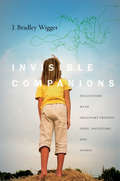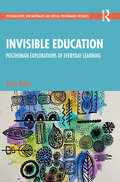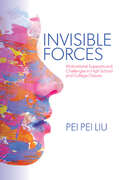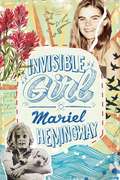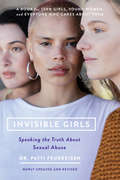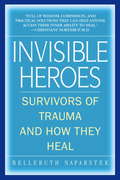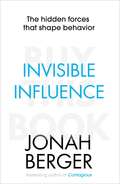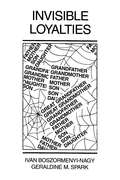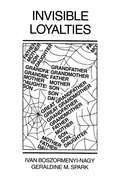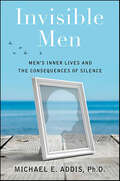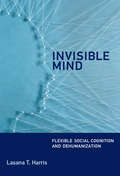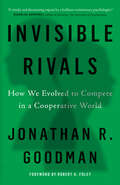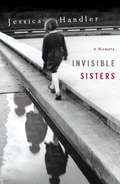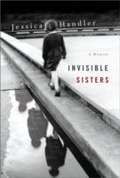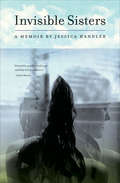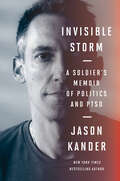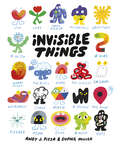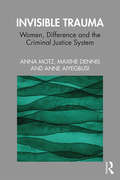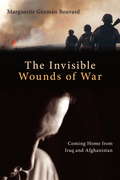- Table View
- List View
Investigative and Forensic Interviewing: A Personality-focused Approach
by Philip Erdberg Craig N. Ackley Shannon M. Mack Kristen BeyerInvestigative and Forensic Interviewing: A Personality-Focused Approach looks at the personality styles most commonly encountered in the criminal justice system and demonstrates how to use this insight to plan and conduct a productive interview. The book includes chapters on narcissistic, antisocial, psychopathic, borderline, inadequate/immature, p
Invisible
by Christine PoulsonLisa has a secret lover, an escape from the pressures of caring alone for her son, who has cerebral palsy. Once a month she meets Jay, just for the weekend, free from all responsibilities. Their time together is perfect – until the day when Jay doesn't show up, and everything she thought she knew about him turns out to be a lie.For Jay it was perfect, too. But he shouldn't have let himself fall in love with Lisa, because now the people who destroyed his entire life five years ago are onto him and he must disappear again …
Invisible
by Christine PoulsonLisa has a secret lover, an escape from the pressures of caring alone for her son, who has cerebral palsy. Once a month she meets Jay, just for the weekend, free from all responsibilities. Their time together is perfect – until the day when Jay doesn't show up, and everything she thought she knew about him turns out to be a lie.For Jay it was perfect, too. But he shouldn't have let himself fall in love with Lisa, because now the people who destroyed his entire life five years ago are onto him and he must disappear again …
Invisible
by Pete HautmanYou could say that my railroad, the Madham Line, is almost the most important thing in my life. Next to Andy Morrow, my best friend. Lots of people think Doug Hanson is a freak -- he gets beat up after school, and the girl of his dreams calls him a worm. Doug's only refuge is creating an elaborate bridge for the model railroad in his basement and hanging out with his best friend, Andy Morrow, a popular football star who could date any girl in school. Doug and Andy talk about everything -- except what happened at the Tuttle place a few years back. It does not matter to Andy that we live in completely different realities. I'm Andy's best friend. It does not matter to Andy that we hardly ever actually do anything together. As Doug retreats deeper and deeper into his own reality, long-buried secrets threaten to destroy both Doug and Andy -- and everything else in Doug's fragile world.
Invisible Boundaries: Psychosis and Autism in Children and Adolescents (The\efpp Monograph Ser.)
by Didier Houzel Maria RhodeThis volume is an outcome of the European Federation for Psychoanalytic Psychotherapy conference on psychotic and autistic conditions in childhood and adolescence, encouraging the cross-fertilization of psychoanalytic practice and theory across the international boundaries in Europe.
Invisible Chains: Overcoming Coercive Control in Your Intimate Relationship
by Lisa Aronson FontesWhen a man showers all of his attention on a woman, it can feel incredibly romantic, and can blind her to hints of problems ahead. But what happens when that attentiveness becomes domination? In some relationships, the desire to control leads to jealousy, threats, micromanaging--even physical violence. If you or someone you care about are trapped in a web of coercive control, this book provides answers, hope, and a way out. Lisa Aronson Fontes draws on both professional expertise and personal experience to help you:*Recognize controlling behaviors of all kinds.*Understand why this destructive pattern occurs.*Determine whether you are in danger and if your partner can change.*Protect yourself and your kids.*Find the support and resources you need.*Take action to improve or end your relationship.*Regain your freedom and independence.
Invisible Companions: Encounters with Imaginary Friends, Gods, Ancestors, and Angels (Spiritual Phenomena)
by J. Bradley WiggerFrom the US to Nepal, author J. Bradley Wigger travels five countries on three continents to hear children describe their invisible friends—one-hundred-year-old robins and blue dogs, dinosaurs and teapots, pretend families and shape-shifting aliens—companions springing from the deep well of childhood imagination. Drawing on these interviews, as well as a new wave of developmental research, he finds a fluid and flexible quality to the imaginative mind that is central to learning, co-operation, and paradoxically, to real-world rationality. Yet Wigger steps beyond psychological territory to explore the religious significance of the kind of mind that develops relationships with invisible beings. Alongside Cinderella the blue dog, Quack-Quack the duck, and Dino the dinosaur are angels, ancestors, spirits, and gods. What he uncovers is a profound capacity in the religious imagination to see through the surface of reality to more than meets the eye. Punctuated throughout by children's colorful drawings of their see-through interlocutors, the book is highly engaging and alternately endearing, moving, and humorous. Not just for parents or for those who work with children, Invisible Companions will appeal to anyone interested in our mind's creative and spiritual possibilities.
Invisible Education: Posthuman Explorations of Everyday Learning (Postqualitative, New Materialist and Critical Posthumanist Research)
by Jocey QuinnThis original and challenging book introduces the ground-breaking concept of ‘invisible education’, theorising it with critical posthuman concepts and demonstrating it through a wide range of empirical research. Invisible education is the learning that happens in everyday life: it is invisible because it is purposively ignored and devalued, and it is education because it is powerful and formative. Far from being marginal, this is where the future is being formed. The book challenges the feel-good fiction of social mobility through formal education, replacing it with the new concept of future mutabilities, shaped through invisible education. The book is the first to bring together lifelong learning and critical posthumanism and does so in ways that are mutually illuminating. The book draws on a wide range of funded empirical research on invisible education: exploring landscapes, animals and things (material, immaterial and uncanny), activism, volunteering and work, home lives and care, and global contexts of conflict. It charts how invisible education plays a crucial role in the lives of marginalised people, including young people, activists, postverbal people, carers, women escaping domestic abuse and many others. Combining posthuman ideas with memoir, poetry, art and fiction, it is creative, intellectually stimulating and readable.
Invisible Forces: Motivational Supports and Challenges in High School and College Classes
by Pei Pei LiuEducators consistently identify student motivation as a top concern, particularly during the transition to college, but often feel helpless to influence it. Some assume that students are simply motivated or not. Others are daunted by trying to shape an unobservable psychological phenomenon. Invisible Forces provides a framework for thinking of student motivation as a set of internal "mindsets" that are promoted or thwarted through a complex ecology of personal, classroom, institutional, and systemic factors. Using the method of portraiture, Pei Pei Liu brings this ecology to life. The book presents a series of four rich case studies of educators' efforts to support student motivation and the challenges they encounter in secondary and postsecondary writing classrooms. Attuned to the unique status of writing-based courses as a near universal academic experience throughout the transition from high school to college, these portraits shed light on different strategies, make a case for institutional support of instructors, and pave the way for greater alignment between secondary and postsecondary settings.
Invisible Girl
by Mariel Hemingway Ben GreenmanWhat is it like to be a teen with depressed addicts for parents, a mentally ill sister, and a grandfather who killed himself? In this moving, compelling diary, Mariel Hemingway writes as her teen self to share her pain, heartache, and coping strategies with young readers."I open my eyes. The room is dark. I hear yelling, smashed plates, and wish it was all a terrible dream." Welcome to Mariel Hemingway's intimate diary of her years as a girl and teen. In this deeply moving, searingly honest young adult memoir, actress and mental health icon Mariel Hemingway shares in candid detail the story of her troubled childhood in a famous family haunted by depression, alcoholism, mental illness, and suicide. Born just a few months after her grandfather, Ernest Hemingway, shot himself, Mariel's mission as a girl was to escape the desperate cycles of debilitating mental health that had plagued generations of her family. In a voice that speaks to young readers everywhere, she recounts her childhood growing up in a family tortured by alcoholism (both parents), depression (her sister Margaux), suicide (her grandfather and four other members of her family), schizophrenia (her sister Muffet), and cancer (mother). It was all the young Mariel could do to keep her head. She reveals her painful struggle to stay sane as the youngest child in her family, and how she coped with the chaos by becoming OCD and obsessive about her food. Young readers who are sharing a similar painful childhood will see their lives and questions reflected on the pages of her diary--and they may even be inspired to start their own diary to channel their pain. Her voice will speak directly to teens across the world and tell them there is light at the end of the tunnel. * A hugely important subject for millions (around 10% of Americans suffer from depression) of young adults who are perhaps growing up in families with mental illness, suicide, depression, schizophrenia, alcoholism, and depression, or who themselves suffer from it. * Very few memoirs speak directly to YA readers about mental illness, depression, and what it is like growing up in a troubled family. * Mariel Hemingway speaks honestly about her own experiences with depression, eating disorders, and OCD, and how she learned to overcome these issues.
Invisible Girls: The Truth About Sexual Abuse
by Patti FeuereisenA powerful source of healing for teen girls and young women who have experienced sexual abuse, Invisible Girls offers survivors agency and hope in an era when too many girls have suffered aloneThe statistics are staggering. One in four girls will experience sexual abuse by the time she is sixteen, and 48 percent of all rapes involve a young woman under the age of eighteen. It's not surprising then, that in a society where sexual abuse of young women is rampant, many women never share their stories. They remain hidden and invisible. In her pioneering work with young survivors through the last thirty years, Dr. Patti Feuereisen has helped teen girls and young women to find their voices, begin healing, and become visible. In this revised second edition, Dr. Patti's gentle guidance and the girls' powerful stories continue to create an encouraging message: Remarkable healing is possible if girls learn to share their stories in their teens and early twenties. With a new introduction, new chapters, and updated resources, this new edition of Invisible Girls has even more to offer girls, young women, and those who care about them.
Invisible Heroes: Survivors of Trauma and How They Heal
by Belleruth NaparstekIf you or someone you love has suffered a traumatic event, you know the devastating impact it can have on your life and your spirit. Life-threatening accidents, illnesses, assaults, abusive relationships--or a tragedy like 9/11--all can leave deep emotional wounds that persist long after physical scars have healed. Survivors become "invisible heroes," courageously struggling to lead normal lives in spite of symptoms so baffling and disturbing that they sometimes doubt their own sanity. Now there is new hope for the millions affected by posttraumatic stress disorder (PTSD). Drawing on more than thirty years' experience as a therapist and on the most recent cutting-edge research, Belleruth Naparstek presents a clinically proven program for recovery using the potent tool of guided imagery. She reveals how guided imagery goes straight to the right side of the brain, where it impacts the nonverbal wiring of the nervous system itself, the key to alleviating suffering. Filled with the voices of real trauma survivors and therapists whose lives and work have been changed by this approach, Invisible Heroes offers: * New understanding of the physical, cognitive, emotional, and behavioral effects of PTSD, who is most susceptible, and why symptoms can get worse rather than better with time * Important insights into how the brain and body respond to trauma, why conventional talk therapy can actually impede recovery, and why the nonverbal, image-based right brain is crucial to healing * A step-by-step program with more than twenty scripts for guided-imagery exercises tailored to the three stages of recovery, from immediate relief of anxiety attacks, flashbacks, nightmares, and insomnia, to freedom from depression and isolation, to renewed engagement with life * A helpful guide to the best of the new imagery-based therapies, and how to incorporate them into an overall recovery plan Belleruth Naparstek concludes with the inspiring words of survivors who have found their way back to peace, purpose, and a deep joy in living. Her compassionate, groundbreaking book can lead you and those in your care to the same renewal and healing. From the Hardcover edition.
Invisible Influence: The hidden forces that shape behaviour
by Jonah BergerIf you're like most people, you think that your choices and behaviors are driven by your individual, personal tastes and opinions. You picked a jacket because you liked the way it looked. You picked a particular career because you found itinteresting. The notion that our choices are driven by our own personal thoughts and opinions seems so obvious that it is not even worth mentioning. Except that it's wrong. Without our realizing it, other people's behavior - what psychologists call "social influence" - has a huge influence on everything we do at every moment of our lives, from the mundane (which movie to see or place to have lunch) to the momentous (which career path to take or person to marry). We make riskier decisions because someone patted us on the shoulder. We like the name Mia because Madison and Sophia are popular names this year. Even strangers, or people we may never meet, have a startling impact on our judgments and decisions: our attitudes towards a welfare policy totally shift if we're told it is supported by Democrats versus Republicans, even though the policy is the same in both cases. But social influence doesn't just lead us to do the same things as others. Like a magnet it can attract, but it also can repel. In some cases we conform, or imitate others around us. But in other cases we diverge, or avoid particular choices or behaviors because other people are doing them. We stop listening to a band because they go mainstream. We skip buying the minivan because we don't want to look like the soccer mom. By understanding how social influence works, we can decide when to resist and when to embrace it: we can affect others behavior and use others to help us make better-informed decisions.
Invisible Loyalties
by Ivan Boszormenyi-NagyFirst published in 1984. Routledge is an imprint of Taylor & Francis, an informa company.
Invisible Loyalties: Reciprocity in Intergenerational Family Therapy
by Ivan Boszormenyi-Nagy Geraldine M. SparkThis book intends to provide a cohesive theoretical foundation for understanding the deeper structuring forces of meaningful human relationships,broad-based applications in family therapy, individual psychodynamics and interactional technology.
Invisible Men: Men's Inner Lives and the Consequences of Silence
by Michael E. AddisAward-winning research psychologist Michael E. Addis identifies and provides answers surrounding the long-unspoken epidemic of silence and vulnerability in menDrawing on scientific research, as well as his own personal and clinical experience, award-winning research psychologist Michael E. Addis describes in this book an epidemic of personal, relational, and societal problems that are caused by the widespread invisibility of men's vulnerabilities. From increasing rates of suicide among men, to alcohol abuse, to violence and school shootings, his research reveals the continued cost of staying silent when emotional, physical, or spiritual pain enters men's lives. In the spirit of such bestsellers as William Pollack's Real Boys, Addis identifies the specific problems that result from men's silence and invisibility, what causes them, and how they can be changed. Addis provides readers with compelling stories of the causes and consequences of silence and invisibility in real men's lives. Invisible Men shows both male and female readers how they can break through the gauntlets that appear to protect men, but in reality cause severe harm to men, women, and families.
Invisible Mind: Flexible Social Cognition and Dehumanization
by Lasana T. HarrisAn interdisciplinary view of the evolution and consequences of flexible social cognition—the capacity to withhold the inference of mental states to other people. In Invisible Mind, Lasana Harris takes a social neuroscience approach to explaining the worst of human behavior. How can a person take part in racially motivated violence and then tenderly cradle a baby or lovingly pet a puppy? Harris argues that our social cognition—the ability to infer the mental states of another agent—is flexible. That is, we can either engage or withhold social cognition. If we withhold social cognition, we dehumanize the other person. Integrating theory from a range of disciplines—social, developmental, and cognitive psychology, evolutionary anthropology, philosophy, economics, and law—with neuroscience data, Harris explores how and why we engage or withhold social cognition. He examines research in these different disciplines and describes biological processes that underlie flexible social cognition, including brain, genetic, hormonal, and physiological mechanisms. After laying out the philosophical and theoretical terrain, Harris explores examples of social cognitive ability in nonhumans and explains the evolutionary staying power of this trait. He addresses two motives for social cognition—prediction and explanation—and reviews cases of anthropomorphism (extending social cognition to entities without mental states) and dehumanization (withholding it from people with mental states). He discusses the relation of social cognition to the human/nonhuman distinction and to the evolution of sociality. He considers the importance of social context and, finally, he speculates about the implications of flexible social cognition in such arenas for human interaction as athletic competition and international disputes.
Invisible Rivals: How We Evolved to Compete in a Cooperative World
by Jonathan R GoodmanA multidisciplinary view of how our competitive and cooperative natures make us human For centuries, people have argued about whether humans are moral animals—good or bad, cooperative or competitive, altruistic or selfish. The debates continue today, dressed up in the language of modern science. In this book, Jonathan R. Goodman makes the case for synthesizing the two sides. Drawing on insights from anthropology, evolutionary biology, and philosophy, he argues that rather than being fundamentally cooperative or competitive, we are capable of being both—and of exploiting each other when there is an opportunity to do so. The core of invisible rivalry is how we make ourselves and others believe that we are acting cooperatively even as we manipulate those around us for our own benefit. In confronting this collective tendency toward self-interest, Goodman says, we can make the fundamental first step in fixing the breakdown of trust in society. Consequently, we will be better able to combat the myriad issues we face today, including widespread inequality, misinformation in a new technological environment, and climate change.
Invisible Sisters
by Jessica HandlerWhen Jessica Handler was eight years old, her younger sister Susie was diagnosed with leukemia. To any family, the diagnosis would have been upending, but to the Handlers, whose youngest daughter Sarah had been born with a rare congenital blood disorder, it was an unimaginable verdict. By the time Jessica Handler turned nine, she had begun to introduce herself as the "well sibling;” and her family had begun to come apart. Invisible Sisters is Handler’s powerfully told story of coming of age--as the daughter of progressive Jewish parents who move south to participate in the social-justice movement of the 1960s; as a healthy sister living in the shadow of her siblings’ illness; and as a young woman struggling to step out of the shadow of her sisters’ deaths, to find and redefine herself anew. With keen-eyed sensitivity, Handler’s brave account explores family love and loss, and what it takes not just to survive, but to keep living.
Invisible Sisters: A Memoir
by Jessica HandlerWhen Jessica Handler was eight years old, her younger sister Susie was diagnosed with leukemia. To any family, the diagnosis would have been upending, but to the Handlers, whose youngest daughter Sarah had been born with a rare congenital blood disorder, it was an unimaginable verdict. By the time Jessica Handler turned nine, she had begun to introduce herself as the "well sibling;" and her family had begun to come apart.Invisible Sisters is Handler's powerfully told story of coming of age--as the daughter of progressive Jewish parents who move south to participate in the social-justice movement of the 1960s; as a healthy sister living in the shadow of her siblings' illness; and as a young woman struggling to step out of the shadow of her sisters' deaths, to find and redefine herself anew. With keen-eyed sensitivity, Handler's brave account explores family love and loss, and what it takes not just to survive, but to keep living.
Invisible Sisters: A Memoir
by Jessica HandlerThe acclaimed author of The Magnetic Girl delivers &“an elegy for her dead sisters . . . a heartfelt, painful family saga, skillfully told by a survivor&” (Kirkus Reviews). When Jessica Handler was eight years old, her younger sister Susie was diagnosed with leukemia. To any family, the diagnosis would have been upending, but to the Handlers, whose youngest daughter, Sarah, had been born with a rare, fatal blood disorder, it was an unimaginable verdict. Struck by the unlikelihood of siblings sick with diametrically opposed illnesses, the medical community labeled the Handlers&’ situation a bizarre coincidence. By the time she was nine years old, Jessica had begun to introduce herself as the &“well sibling.&” Deeply moving and exquisitely written, Invisible Sisters is an extraordinary story of coming of age as the odd one out—as the daughter of progressive Jewish parents who moved to the South to participate in the civil rights movement of the 1960s, as the healthy sister among sick, and eventually, as the only sister left standing. In a book that is as hard to forget as it is to put down, Handler captures the devastating effects of illness and death on a family and the triumphant account of one woman&’s enduring journey to step out of the shadow of loss to find herself anew. &“An unsentimental but deeply moving look at the ways in which loss––loss past and the loss that is still to come––can shape lives . . . a quiet, near-hypnotic tour de force.&”—Michael Wex, New York Times bestselling author of Born to Kvetch &“Both heartbreaking and hopeful.&”—Ann Hood, bestselling author of The Book That Matters Most
Invisible Storm: A Soldier's Memoir of Politics and PTSD
by Jason KanderFrom political wunderkind and former army intelligence officer Jason Kander comes a haunting, powerful memoir about impossible choices—and how sometimes walking away from the chance of a lifetime can be the greatest decision of all. <p><p>In 2017, President Obama, in his final Oval Office interview, was asked who gave him hope for the future of the country, and Jason Kander was the first name he mentioned. Suddenly, Jason was a national figure. As observers assumed he was preparing a run for the presidency, Jason announced a bid for mayor of Kansas City instead and was headed for a landslide victory. But after eleven years battling PTSD from his service in Afghanistan, Jason was seized by depression and suicidal thoughts. He dropped out of the mayor’s race and out of public life. And finally, he sought help. <p><p>In this brutally honest second memoir, following his New York Times best-selling debut Outside the Wire, Jason Kander has written the book he himself needed in the most painful moments of his PTSD. In candid, in-the-moment detail, we see him struggle with undiagnosed illness during a presidential bid; witness his family buoy him through challenging treatment; and, giving hope to so many of us, see him heal. <p> <b>New York Times Bestseller</b>
Invisible Things
by Andy J. Pizza Sophie MillerThis creatively wacky exploration of the invisible things that make up the human experience encourages readers to look past the visible and connect with the things that are not seen. <p><p> If we could put on a pair of magical invisible glasses and see all the feelings, ideas, and other invisible things that populate our world, what would they look like? Could you see an itch? Could you describe hope? From the sound of a dog barking to the rainbow-MAGIC taste of a lollipop, from gratitude to grit, this book will help you meet the many interesting sensations that follow you every day, even if you can't see them*.* <p><p> Explore the way a sad song can sometimes make you happy and discover that laughs—even fake ones—can multiply faster than you'd imagine. As readers give these unknown forces a name, they'll also find a gentle invitation to pause, take a deep breath, and reflect on the invisible things at work in their own lives. <p><p> NAME THE INVISIBLE THING: There are hidden forces that impact our everyday, particularly for kids. Giving those forces a name, and even a face, helps kids to feel empowered. <p><p> PROMPT FOR CONVERSATION: Educators, therapists, and caregivers looking to have nuanced or challenging conversations with kids about their own experiences can use this as a jumping off point for conversation: What invisible things can you name in your life? <p><p> SOCIAL EMOTIONAL LEARNING: One common exercise teachers use is to ask kids to point to their emotion on a chart and then name it, for which this book will be a powerful tool. <p><p> REVIEWED BY MENTAL HEALTH EXPERT: This book was vetted by a licensed independent clinical social worker specializing in mental health for kids! <p><p> POPULAR AUTHOR: Andy J. Pizza is one of the creative minds behind the bestselling A Pizza with Everything on It and also hosts the popular podcast Creative Pep Talk. <p><p> VIRAL HIT: Andy J. Pizza's original "Invisible Things" posts on Twitter went viral, with 57,000 likes and 25,000 retweets; his ongoing Instagram posts receive thousands of likes and shares. It's clear people are ready to see INVISIBLE THINGS <p><p> Perfect for: <p> Anyone interested in social-emotional learning (SEL) and entertaining ways to explore emotions with kids <p>Anyone looking for interactive or artful books about mental health <p><p><p>Fans of classic children's books like Dr. Seuss's My Many Colored Days, Molly Bang's When Sophie Gets Angry--Really, Really Angry . . ., and Judith Viorst's Alexander and the Terrible, Horrible, No Good, Very Bad Day Fans of Pixar's Inside Out Fans of Andy J. Pizza, his original twitter post about "Invisible Things" that went viral, the Creative Pep Talk podcast, or A Pizza with Everything on It <P><P><i>Advisory: Bookshare has learned that this book offers only partial accessibility. We have kept it in the collection because it is useful for some of our members. Benetech is actively working on projects to improve accessibility issues such as these.</i> <p> <b>New York Times Bestseller</b>
Invisible Trauma: Women, Difference and the Criminal Justice System
by Anna Motz Anne Aiyegbusi Maxine DennisThere is an expectation that women will be nurturers and carers. Women who have been judged violent, destructive and criminal and who are detained in the criminal justice system can find themselves perceived through a distorted lens as unwomanly. This book explains how they become hypervisible in their difference, while the histories of trauma and suffering that are communicated through their offending and other risk behaviour remain hidden, and so are unseen. Bringing together authors uniquely placed as experts in their fields, Invisible Trauma argues that it is essential to trace the traumatic roots of women’s violence and criminality. Powerful intergenerational factors perpetuate the cycles of offending and trauma re-enactment that current sentencing practice overlooks. The authors present a psychoanalytically informed account of the development of violence and other offending, identifying pathways for change to address trauma within the lives of these women and their children, and also to create a responsive, effective and sensitive workforce. Invisible Trauma highlights the role of emotional, social and cultural forces in traumatising women who come into contact with the criminal justice system and uncovers areas of their lives that are all too often hidden from view. It will be invaluable to those working in clinical and forensic psychology, mental health nursing, psychotherapy, social work, medical practice and women’s health, as well as frontline practitioners in the criminal justice system, the health service and third sector organisations and for anyone with an interest in racism, equality and social justice.
Invisible Wounds of War: Coming Home from Iraq and Afghanistan
by Marguerite Guzman Bouvard<p>There’s no real homecoming for many of our veterans returning from the wars in Iraq and Afghanistan. They may go through the motions of daily life in their hometowns, but the terrible sights and sounds of war are still fresh in their minds. <p>This empathic, inside look into the lives of our combat veterans reveals the lingering impact that the longest wars in our nation’s history continue to have on far too many of our finest young people. Basing her account on numerous interviews with veterans and their families, the author examines the factors that have made these recent conflicts especially trying. <p>A major focus of the book is the extreme duress that is a daily part of a soldier’s life in combat zones with no clear frontlines or perimeters. Having to cope with unrecognizable enemies in the midst of civilian populations and attacks from hidden weapons like improvised explosive devices exacts a heavy toll. Compounding the problem is the all-volunteer nature of our armed forces, which often demands multiple deployments of enlistees. This results in frequent cases of post-traumatic stress disorder and families disrupted by the long absence of one and sometimes both parents. <p>The author also discusses the lack of connectedness between civilian society and military personnel, leading to inadequate healthcare for many veterans. This deficiency has been highlighted by the urgent need to treat traumatic brain injuries in survivors of explosions and the high veteran suicide rate. <p>Bouvard concludes on a positive note by discussing some of the surprising and encouraging ways that the chasm between civilian and military life is being bridged to help reintegrate our returning soldiers. For veterans, their families, and especially for civilians unaware of how much our soldiers have endured, <i>The Invisible Wounds of War</i> is important reading.</p>
